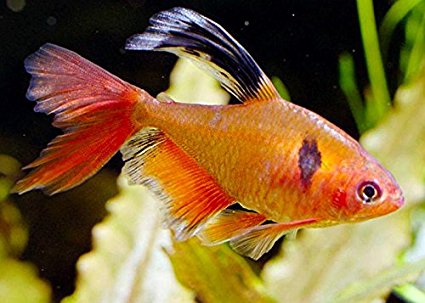
Longfin Serpae tetras are another one of those very hardy type larger tetras but with the added bonus of the long flowy finnage. Their distinctive red colour, hardiness and peaceful nature makes them an ideal choice for a tropical community aquarium, or even in a cold water set up in some parts where the climate is suitable.
Common Name(s) : Longfin Serpae Tetra, Longfin Jewel Tetra, Longfin Red Minor Tetra,
Family : Characidae
Genus: Hyphessobrycon
Species : Hyphessobrycon eques
Origin : Brazil, Peru, Paraguay, Bolivia and northern Argentina
PH : 6.0 – 7.5
Hardness : Soft to Hard
Temperature : 22 – 28°C / 61–82°F
Maximum Size : 5cm / 2′
Lifespan : 5 years
Aggression Level : Peaceful
Recommended Tank Size : 30 Litres +
Strata : Bottom Half
TANK SET UP
Prefer a planted tank. Add some driftwood plants to help create their natural environment.
SUITABLE TANK MATES
Angelfish | Barb | Betta | African Cichlids | American Cichlids | American Dwarf Cichlids | Bristlenose Catfish | Corydoras Catfish | Tandanus Catfish | Other Catfish | Danios | Whiteclouds | Medakas | Discus | Eels | Flying Fox | Common Goldfish | Fancy Goldfish | Dwarf Gouramis | Large Gouramis | Gudgeons | Guppies | Killifish | Loaches and Botia | Mollies | Murray Cod | Oscars and other large Cichlids | Silver and Golden Perch | Plants | Platys | Rainbowfish | Rasbora | Saratoga | Sharks | Silver Dollar | Shrimp / Yabbies / Crabs | Snails | Swordtails | Tetras
DIET
Omnivores, in the wild they eat very small invertebrates and plants. In the aquarium they will accept a wide range of foods including flake, small pellets, bloodworms and brine shrimp.
SEXING AND BREEDING
Female Serpae tetras are generally larger than the males and have a plumper, rounder body. A male will have a more elongated appearance featuring a slightly brighter colour – particularly whilst leading up to breeding.
To breed them, condition a male and female for several weeks feeding them plenty of frozen food. Remove a male and a female into a bare glass bottom tank. Drop the hardness of the water to 4dGH and the PH to slightly acidic. Keep lighting to a minimum (promotes fungal growth in the eggs) and add some floating plants. They will scatter eggs within days, and once you have spotted the tiny little eggs, remove the parents and add them back into the community tank once again. Eggs hatch within 48 hours. Usually after 5 days you can see free swimming fry.
Java Moss can be added for the fry to hide and feed on
OTHER USEFUL INFORMATION
Serpae tetras are another on of those very hardy type larger tetras. Their distinctive red colour, hardiness and peaceful nature makes them an ideal choice for a tropical community aquarium, or even in a cold water set up.
Originating in the amazon basin, they are found in rivers and streams featuring dense planted areas of weed. For this reason it is recommended you replicate a similar setup for your aquarium.
Like all tetras, we also recommend you keep them in a school of 6 or more. They will however school up with other tetras of similar size and shape.
Serpae tetras survive a wide range of water parameters .. the water PH can be anywhere between 6 and 7.5 and the ideal temperature between 22°C and 28°C. These fish however have been well known to survive in cold water – dependent on your location and climate of course.
